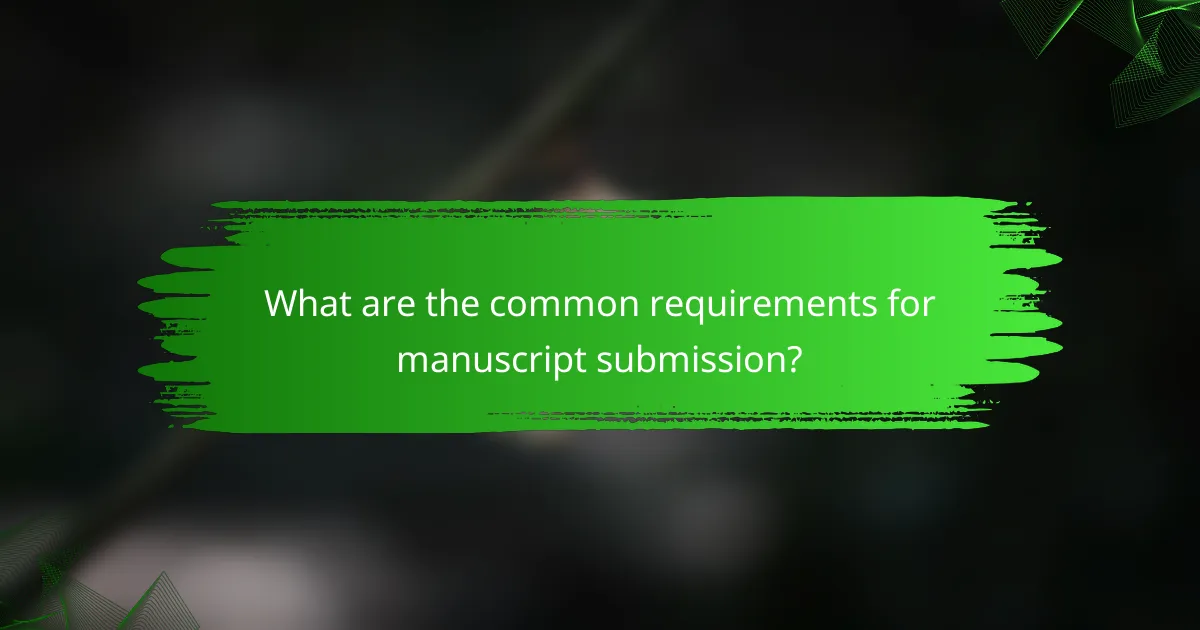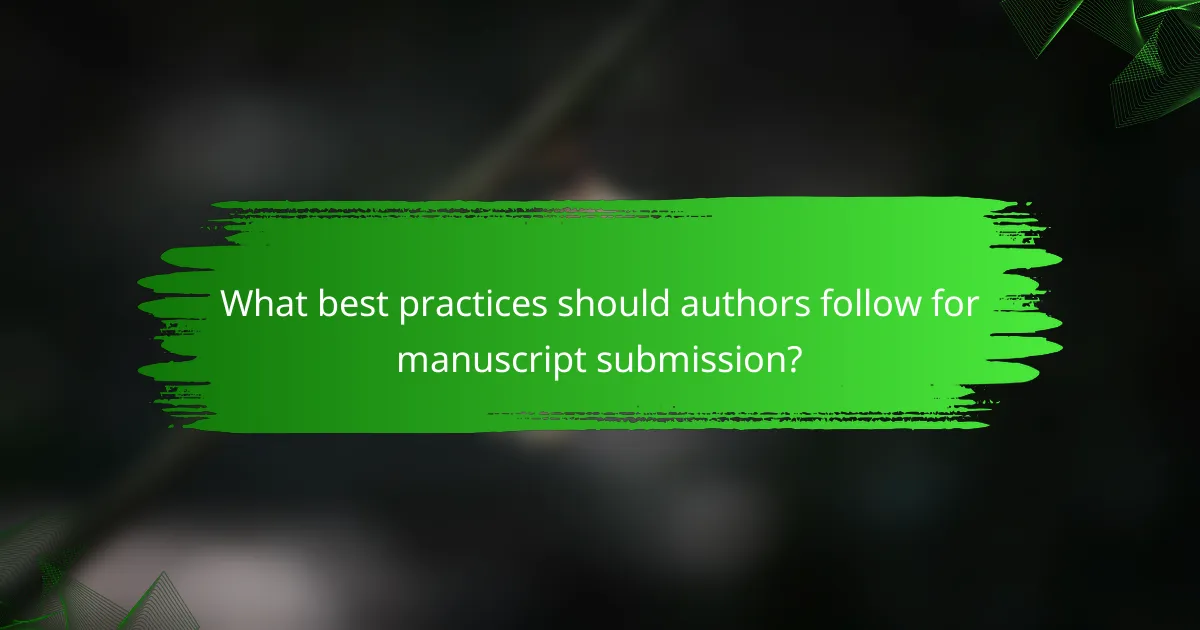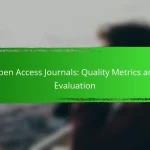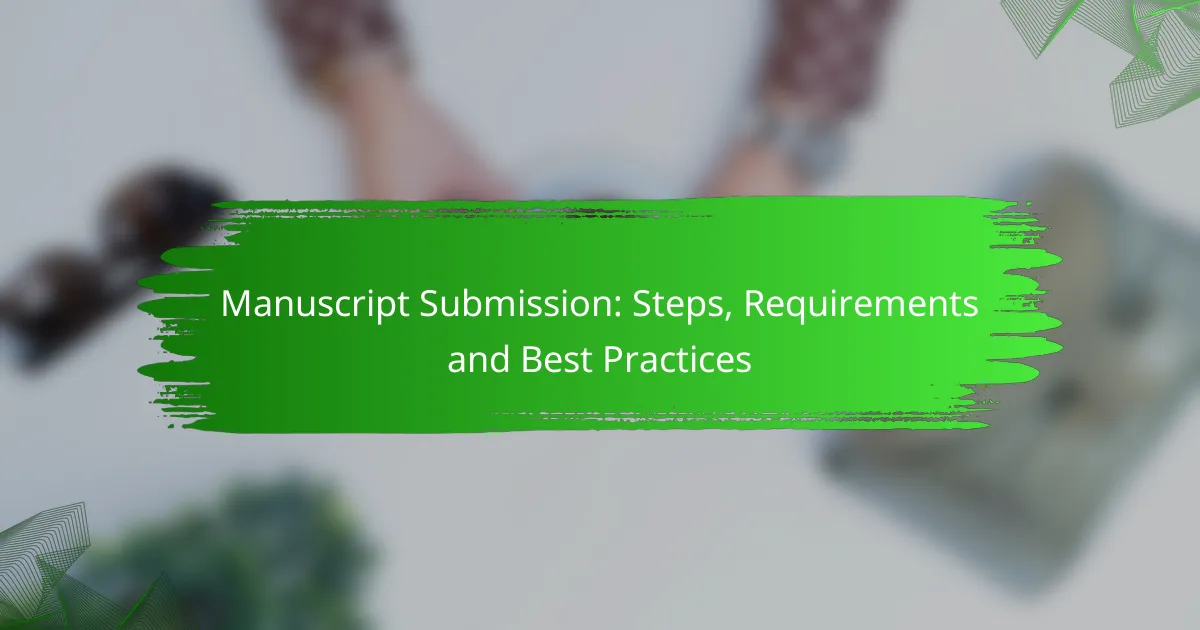The manuscript submission process is a critical journey for authors, involving essential steps such as preparation, journal selection, and adherence to specific guidelines. Understanding the common requirements and best practices can significantly enhance the likelihood of acceptance by publishers. By meticulously following these steps and ensuring compliance with ethical standards, authors can present their work in the best possible light.

What are the steps for manuscript submission in the UK?
The manuscript submission process in the UK involves several key steps, including initial preparation, journal selection, formatting, submission, and post-submission actions. Each step is crucial to ensure that your work meets the expectations of publishers and reviewers.
Initial preparation of the manuscript
Before submitting your manuscript, ensure that it is thoroughly researched and well-written. This includes conducting a comprehensive literature review and ensuring your arguments are clearly articulated. You should also gather all necessary supplementary materials, such as figures, tables, and appendices.
Consider seeking feedback from colleagues or mentors to refine your manuscript. This peer review can help identify weaknesses and improve the overall quality before submission.
Choosing the right journal
Selecting an appropriate journal is vital for successful manuscript submission. Research journals that align with your field and the specific topic of your manuscript. Look for journals that have a good reputation and a history of publishing similar work.
Check the journal’s aims and scope, as well as its impact factor and audience. This will help ensure that your work reaches the right readers and has the potential for a significant impact.
Formatting requirements
Each journal has specific formatting guidelines that must be followed. These may include requirements for font size, margins, citation style, and overall structure. Carefully review the journal’s author guidelines to ensure compliance.
Common formatting elements include title page setup, abstract length, and reference formatting. Non-compliance with these requirements can lead to delays or rejection of your manuscript.
Submission process overview
The submission process typically involves creating an account on the journal’s submission platform. You will need to upload your manuscript and any supplementary materials, fill out necessary metadata, and agree to copyright terms.
After submission, you will receive a confirmation email. Be prepared for the peer review process, which may take several weeks to months, depending on the journal’s timelines.
Post-submission actions
Once your manuscript is submitted, monitor your email for updates from the journal. You may receive requests for revisions or additional information from reviewers or editors.
If your manuscript is accepted, follow the journal’s instructions for final submission, including any formatting adjustments. If rejected, consider the feedback provided and decide whether to revise for resubmission or target a different journal.

What are the common requirements for manuscript submission?
Common requirements for manuscript submission include adherence to author guidelines, ethical considerations, conflict of interest disclosures, and data availability statements. Meeting these criteria ensures that your manuscript is considered seriously by publishers and reviewers.
Author guidelines
Author guidelines are specific instructions provided by journals that outline formatting, structure, and style requirements for manuscript submissions. These guidelines typically include details on font size, citation style, and word count limits.
Before submitting, carefully review the journal’s website for these guidelines. Following them closely can significantly increase the chances of your manuscript being accepted without unnecessary revisions.
Ethical considerations
Ethical considerations involve ensuring that your research complies with relevant ethical standards, including obtaining necessary approvals from institutional review boards or ethics committees. This is crucial for studies involving human or animal subjects.
Additionally, authors must ensure that their research does not involve plagiarism or fabrication of data. Adhering to ethical guidelines fosters trust and credibility in the research community.
Conflict of interest disclosures
Conflict of interest disclosures are statements that inform the journal and readers of any financial or personal relationships that could influence the research. Authors are typically required to disclose any funding sources or affiliations that may be perceived as a conflict.
Being transparent about potential conflicts helps maintain the integrity of the research process. Failure to disclose relevant conflicts can lead to retraction of published work or damage to an author’s reputation.
Data availability statements
Data availability statements clarify how and where the data supporting the research findings can be accessed. Many journals now require authors to provide this information to promote transparency and reproducibility in research.
Authors should specify whether data is available upon request, stored in a public repository, or if there are restrictions on access. This practice not only enhances the credibility of the research but also encourages collaboration and further study.

What best practices should authors follow for manuscript submission?
Authors should adhere to several best practices for manuscript submission to enhance their chances of acceptance. Key steps include thorough proofreading, following journal guidelines, utilizing reference management tools, and seeking peer feedback.
Thorough proofreading
Thorough proofreading is essential to eliminate grammatical errors and improve clarity. Authors should review their manuscripts multiple times, focusing on different aspects such as spelling, punctuation, and overall flow.
Consider using tools like Grammarly or Hemingway to assist in identifying mistakes. Additionally, reading the manuscript aloud can help catch awkward phrasing and improve readability.
Adhering to journal guidelines
Every journal has specific submission guidelines that must be followed closely. These guidelines typically cover formatting, word count, citation style, and required sections.
Authors should carefully read the journal’s instructions for authors, ensuring that their manuscript meets all criteria. Failing to adhere to these guidelines can lead to immediate rejection, so it’s crucial to align with the journal’s expectations.
Utilizing reference management tools
Reference management tools, such as EndNote, Mendeley, or Zotero, can streamline the process of organizing citations and formatting references. These tools help maintain consistency and accuracy in citations, which is vital for academic integrity.
Authors should familiarize themselves with a reference manager that suits their needs, as it can save time and reduce errors during the submission process. Properly formatted references enhance the professionalism of the manuscript.
Seeking peer feedback
Seeking feedback from peers can provide valuable insights and improve the quality of the manuscript. Authors should consider sharing their work with colleagues or mentors who can offer constructive criticism.
Incorporating feedback can help identify weaknesses in the argument or structure, leading to a stronger submission. Authors should be open to suggestions and willing to make revisions based on the feedback received.

What are the prerequisites for successful manuscript submission?
Successful manuscript submission requires a clear understanding of the journal’s guidelines, a well-prepared manuscript, and all necessary supplementary materials. Meeting these prerequisites significantly increases the chances of acceptance and reduces the likelihood of delays in the review process.
Understanding journal scope
Before submitting, ensure your manuscript aligns with the journal’s scope. Each journal has specific themes and topics it covers, which can often be found in the “Aims and Scope” section on their website. Submitting to a journal that fits your research area enhances the likelihood of acceptance.
Review recent articles published in the journal to gauge the type of content they prioritize. This can provide insight into the style, depth, and focus areas that resonate with the journal’s audience.
Researching submission timelines
Submission timelines can vary widely between journals, so it’s crucial to check their specific guidelines. Many journals provide estimated timelines for the review process, which can range from a few weeks to several months. Understanding these timelines helps you plan your submission accordingly.
Be aware of any upcoming special issues or deadlines that may affect your submission. Some journals have specific calls for papers that align with particular themes, which can be advantageous for timely publication.
Preparing supplementary materials
Supplementary materials often enhance your manuscript and may include data sets, additional figures, or detailed methodologies. Check the journal’s requirements for these materials, as they may have specific formats or limits on file sizes.
Organize supplementary materials clearly and ensure they are referenced appropriately within your manuscript. This not only aids reviewers in understanding your work but also demonstrates thoroughness and professionalism in your submission.

How can authors improve their chances of acceptance?
Authors can enhance their chances of acceptance by actively engaging with the editorial team, tailoring their manuscript to the target audience, and clearly highlighting their unique contributions. These strategies not only align the submission with the journal’s expectations but also demonstrate professionalism and awareness of the publication process.
Engaging with the editorial team
Establishing a connection with the editorial team can significantly boost your submission’s visibility. Consider reaching out with questions about the journal’s focus or submission guidelines before submitting your manuscript. This proactive approach shows your commitment and can provide valuable insights into what the editors are looking for.
Additionally, attending conferences or workshops where editorial team members are present can facilitate direct communication. Building rapport in these settings may lead to more favorable consideration of your work.
Tailoring the manuscript to the audience
Understanding the journal’s audience is crucial for tailoring your manuscript effectively. Analyze previously published articles to identify themes, writing styles, and topics that resonate with readers. This can help you align your work with the interests and expectations of the journal’s audience.
Moreover, consider the journal’s impact factor and scope when crafting your manuscript. For instance, a more specialized journal may prefer detailed methodologies, while a broader audience might appreciate a more general overview. Adjust your language and complexity accordingly to enhance engagement.
Highlighting unique contributions
Clearly articulating your manuscript’s unique contributions is essential for standing out in a competitive submission process. Start by summarizing how your research addresses gaps in existing literature or offers new insights. Use strong, specific language to convey the significance of your findings.
Incorporate a dedicated section in your manuscript that emphasizes these contributions. Bullet points can be effective for listing key innovations or implications of your work, making it easier for reviewers to grasp its value quickly. Avoid vague statements; instead, focus on concrete examples that showcase the originality of your research.







